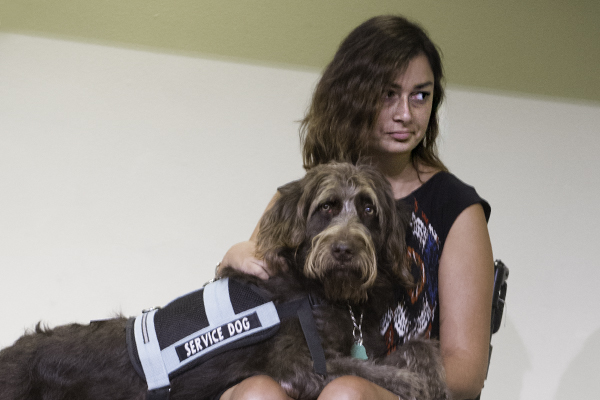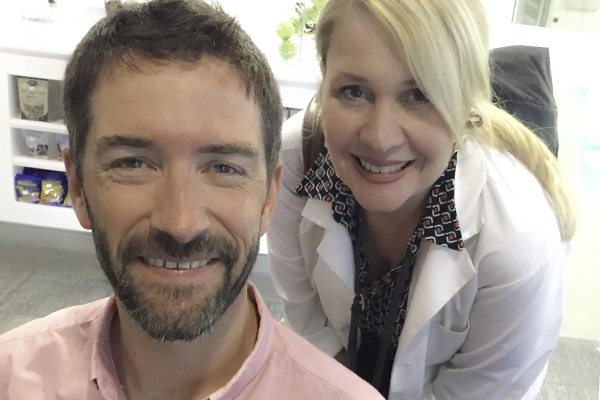Hosted by FARA and the USF Ataxia Research Center, the annual scientific symposium emphasizes a patient-centered approach to research
For the first time in its seven-year history, the Friedreich’s Ataxia Scientific Symposium brought together several pharmaceutical industry leaders to discuss preclinical and clinical studies. The companies are all attacking Friedreich’s ataxia (FA) on different fronts with the same goal in mind: to get the first treatment for the rare, but devastating, neuromuscular disease approved and on the market as soon as possible.
The Sept. 17 symposium, hosted by the Friedreich’s Ataxia Research Alliance (FARA) and the USF Ataxia Research Center, drew an audience totaling more than 500, both live at the USF Marshall Center Ballroom and viewing the event in real-time through Ustream’s CureFA channel.
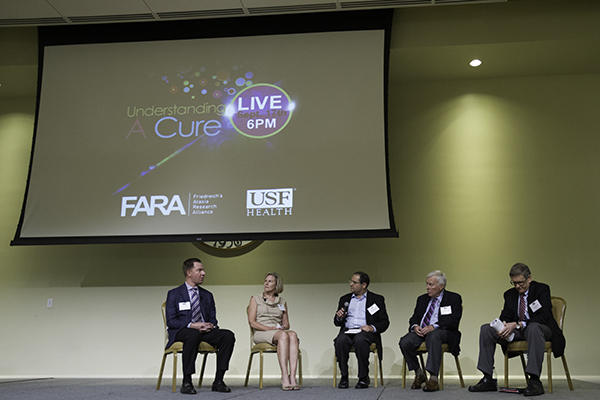
The symposium featured a discussion by leading representatives of pharmaceutical and biotechnology companies working with FARA and academia to conduct new research attacking Friedreich’s ataxia on several fronts.
Representatives and supporters of FARA, the research community, and patient and their families – many whom attended FARA’s Energy Ball gala on Saturday evening, Sept. 19 — were welcomed by USF President Judy Genshaft.
The translational center of excellence at USF is “one of the most active in the world, testing potential new drugs for Friedreich’s ataxia,” President Genshaft said. “We are unstoppable in the fight for a cure for FA.”
In the last seven years, the staff of the USF Ataxia Research Center, focused on identifying and developing effective treatments for inherited ataxia disorders, has expanded to eight, including two clinicians, a fellow, nurses and research coordinators. Center Director Theresa Zesiewicz, MD, professor of neurology, gave an overview of the center’s eight clinical trials — six active and two finishing up. USF, one of 10 sites in the international FARA Collaborative Clinical Research Network, is recruiting patients for two of the three trials presented by pharmaceutical industry leaders at the symposium. The USF center is also working with Agilis, one of the biopharmaceutical companies at the symposium, to develop their gene therapy protocol, expected to be submitted in 2016 to the Food and Drug Administration (FDA).

USF President Judy Genshaft welcomed attendees to the USF Tampa campus for the seventh annual scientific symposium “Understanding Energy for A Cure,” hosted by the Friedreich’s Ataxia Research Alliance and the USF Ataxia Research Center.
Friedreich’s ataxia is triggered by a single genetic defect that limits production of frataxin, a protein vital to the function of the energy-producing factories, or mitochondria, of the cell. This leads to a variety of symptoms including neurodegeneration that can cause muscle weakness and loss of coordination and balance, energy deprivation and fatigue, vision impairment, slurred speech, aggressive scoliosis, diabetes and life-shortening cardiac disease. Most young people diagnosed with Friedreich’s ataxia require a cane, walker or wheelchair by their teens or early 20s. There are currently no approved treatments.
FARA President Ron Bartek and Executive Director Jennifer Farmer spoke about the progress in Friedreich’s ataxia research worldwide and the value of the organization’s 2,600-member patient registry in bringing together all its stakeholders.

FARA’s Executive Director Jennifer Farmer and President Ron Bartek.
Featured speaker Sanjay Bidichandani, MBBS, PhD, the chair of pediatric medical genetics at the University of Oklahoma College of Medicine and member of the FARA Board of Directors, was part of the team that first identified the Friedreich’s ataxia gene in 1996. Fueled by resources and partnerships cultivated by FARA, Dr. Bidichandani said, the understanding of the disease process advanced relatively quickly since that genetic discovery and has yielded robust expansion of investigational drugs in the treatment pipeline.
A panel moderated by Dr. Bidichandani featured representatives from four biotechnology and pharmaceutical companies conducting Friedreich’s ataxia research in collaboration with FARA and academia – Jeffrey Sherman, MD, executive vice president for research and development and chief medical officer, Horizon Pharma; Jodi Cook, PhD, vice president of operations, Agilis Biotherapeutics; Colin Myer, MD, chief medical officer, Reata Pharmaceuticals; and Robert De Jager, MD, chief medical officer, Retrotope. Their newly activated studies cover a range of therapeutic targets, including finding ways to boost frataxin production, improving mitochondrial function, reducing mitochondrial damage and oxidative stress, and delivering gene therapy.
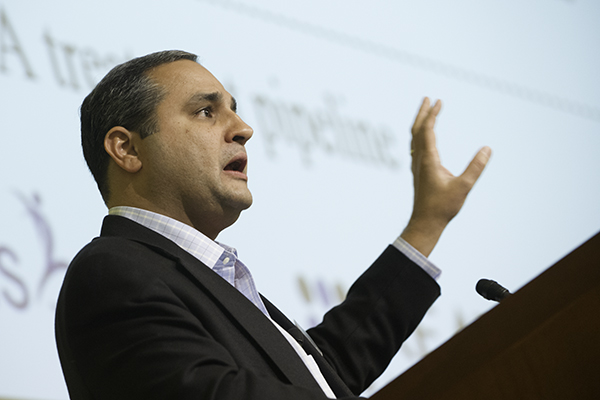
Featured speaker Dr. Sanjay Bidichandani, a member of FARA’s Board of Directors, was part of the group that discovered the gene for Friedreich’s ataxia in 1996. He gave an overview of the tremendous progress in less than 20 years leading to a robust treatment pipeline.
“FARA has really galvanized the patient community, academia, industry and even regulators to develop better insights into this disease and how we can all work together,” said Horizon Pharma’s Dr. Sherman. “At the end of the day, they’ve really brought to the forefront the importance of patient centricity and the voice of the patient in clinical and basic science research.”
Horizon Pharma has repurposed a drug already approved by the U.S. Food and Drug Administration for use in treating two other rare genetic disorders, chronic granulomatous disease and severe malignant osteopetrosis. The company recently launched a Phase 3 randomized, double-blind, placebo-controlled trial to test the safety and effectiveness of Actimmune® (interferon gamma-1b) in improving neurological function in 90 Friedreich’s patients at four U.S. sites. Previous research indicated that Actimmune®, which mimics a protein made by the body to help prevent infection, increases frataxin levels to reduce nerve cell depletion and muscle atrophy.

The symposium brought together representatives and supporters of FARA and the research community with patients in their families.
Agilis focuses on engineering and delivering therapeutic DNA to replace the damaged frataxin gene. Preclinical studies are employing a safe virus to optimally deliver the corrective gene to key targets, allowing safe and effective long-term expression of the frataxin protein.
Earlier this year Reata began a Phase 2 randomized, placebo-controlled, double-blind trial testing the safety and effectiveness of various dose levels of the oral medication RTA 408 in treating Friedreich’s ataxia. Known as the MOXle study, the trial is enrolling patients at sites worldwide, including USF. Preclinical studies have shown that RTA 408 directly activates antioxidative pathways to improve mitochondrial function.
This month USF enrolled the first of 18 patients in Retrotope’s 28-day randomized, double-blind controlled trial evaluating the safety of the investigational oral drug RT001 in ambulatory patients with Friedreich’s ataxia. USF and the University of California Los Angeles will be the only two sites for the Phase 1 study. The compound RT001 is a stabilized fatty acid shown to shut down the toxic free radical degradation of polyunsaturated fats, an essential component of cell membranes, and reduces further damage to the mitochondria.
The scientific panel was followed by a question-and-answer session on patients’ perspectives of living with Friedreich’s ataxia. The panel was moderated by symposium host Clifton Gooch, MD, professor and chair of the Department of Neurology at the USF Health Morsani College of Medicine.
The four patient participants, all diagnosed in their teens or early 20s, emphasized a common theme – that they choose every day to carry on and live life to its fullest despite the challenges of Friedreich’s ataxia.
Jade Perry, 25, was accompanied to the stage by the service dog she trained, a labradoodle named Bo. Perry, who is finishing up a master’s degree in education from Coastal Carolina University, recently got her first full-time teaching job.
“I love riding my trike and try to keep my schedule packed so FA can’t slow me down,” she said.

Kendall Harvey, center, was diagnosed with later-stage Friedreich’s ataxia three years ago at age 25. “In spite of my diagnosis, my family and I are living life to the fullest,” she said.
Kendall Harvey, 28, diagnosed at age 25 with later-onset Friedreich’s ataxia, still walks unassisted. She and her husband live in Austin, TX, with their 11-month old son Brooks.
Harvey, who participated in volleyball, track and other sports as a youth, said she noticed problems with agility and balance while taking dance lessons in preparation for her 2013 wedding. She chalked it up to getting a little older or “being out of shape.” But continuing symptoms finally led her to a neurologist who ran a battery of tests, culminating with a full genetic panel.
“The first time I heard of FA was the day I was diagnosed,” Harvey said. “FA has changed my perspective. Now, I live more in the moment than worrying about all the things in the future.
“On the days when I stumble a little more, my speech is slurred and I’m angry that my body is not behaving the way I’d like, my son is a fantastic reminder that I’m still capable of amazing things. He’s very humbling.”
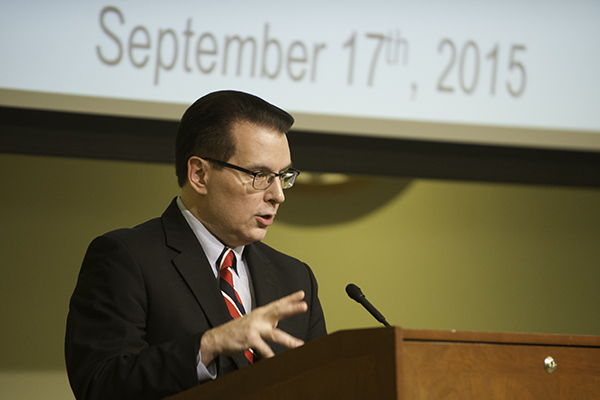
In his closing remarks Dr. Clifton Gooch, professor and chair of neurology at the USF Health Morsani College of Medicine, encouraged continued collaboration in the fight to find effective treatments and a cure for Friedreich’s ataxia.
USF’s Dr. Gooch closed the symposium by emphasizing the tremendous progress made in the research and development of lead drug candidates for Friedreich’s ataxia and encouraging all to continue to carry on the fight against the disease with laser focus.
“When pharma becomes engaged, that means the research is good enough to put smart money behind the disease to get a drug to market,” Dr. Gooch said. “There is more than just a glimmer of hope. We’re on the cusp of great possibilities… We look forward to the day when Friedreich’s ataxia will become a historical footnote like smallpox.”
For more information on the FARA patient registry, which provides notices about new clinical trials, go to http://www.curefa.org/patient-registry
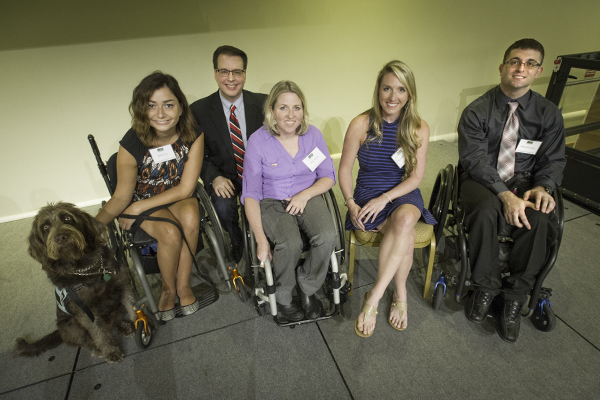
Dr. Gooch, second from left, moderated the question and answer session with patients, l to r, Jade Perry, Erin O’Neil, Kendall Harvey, and Chris Nercesian.
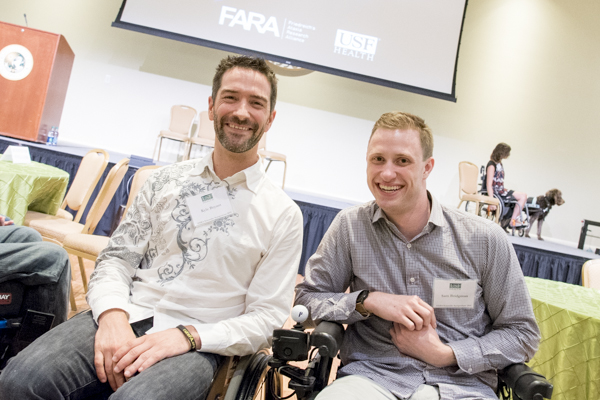
Kyle Bryant with Sam Bridgman, who recently received a full scholarship to attend the graduate program at the USF Muma College of Business.
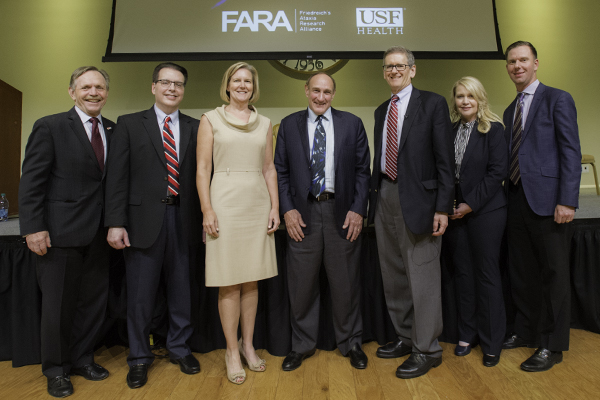
L to R: FARA President Ron Bartek; Dr. Clifton Gooch, chair of USF Health Neurology; Dr. Jodi Cook, vice president of operations, Agilis Biotherapeutics; Dr. Robert Molinari, founder and CEO of Retrotope; Dr. Jeffrey Sherman, CMO, Horizon Pharma; Dr. Theresa Zesiewicz, director, USF Ataxia Research Center; and Dr. Colin Myer, CMO, Reata Pharmaceutical.
Photos by Eric Younghans, video by Sandra C. Roa, USF Health Communications and Marketing
